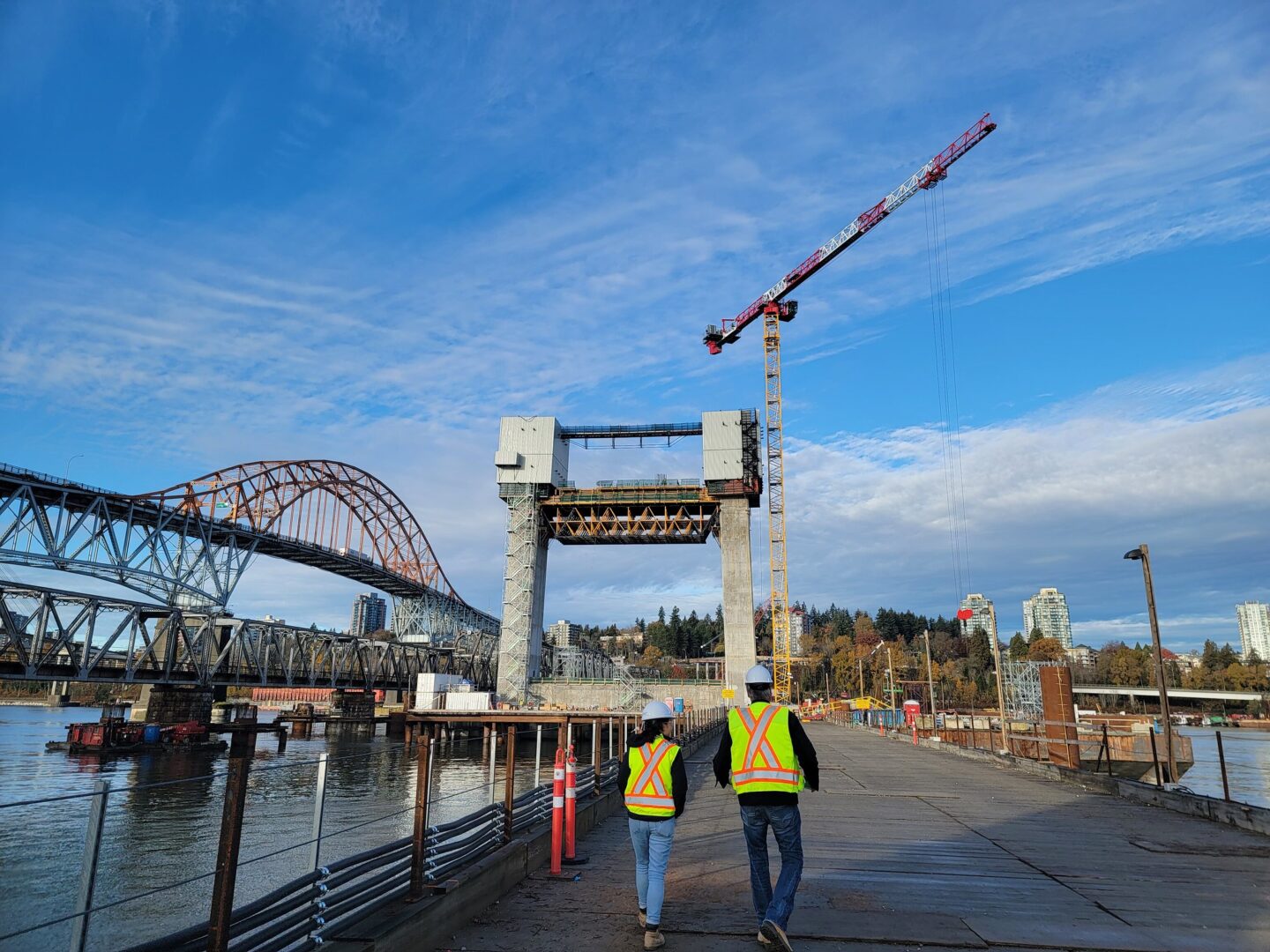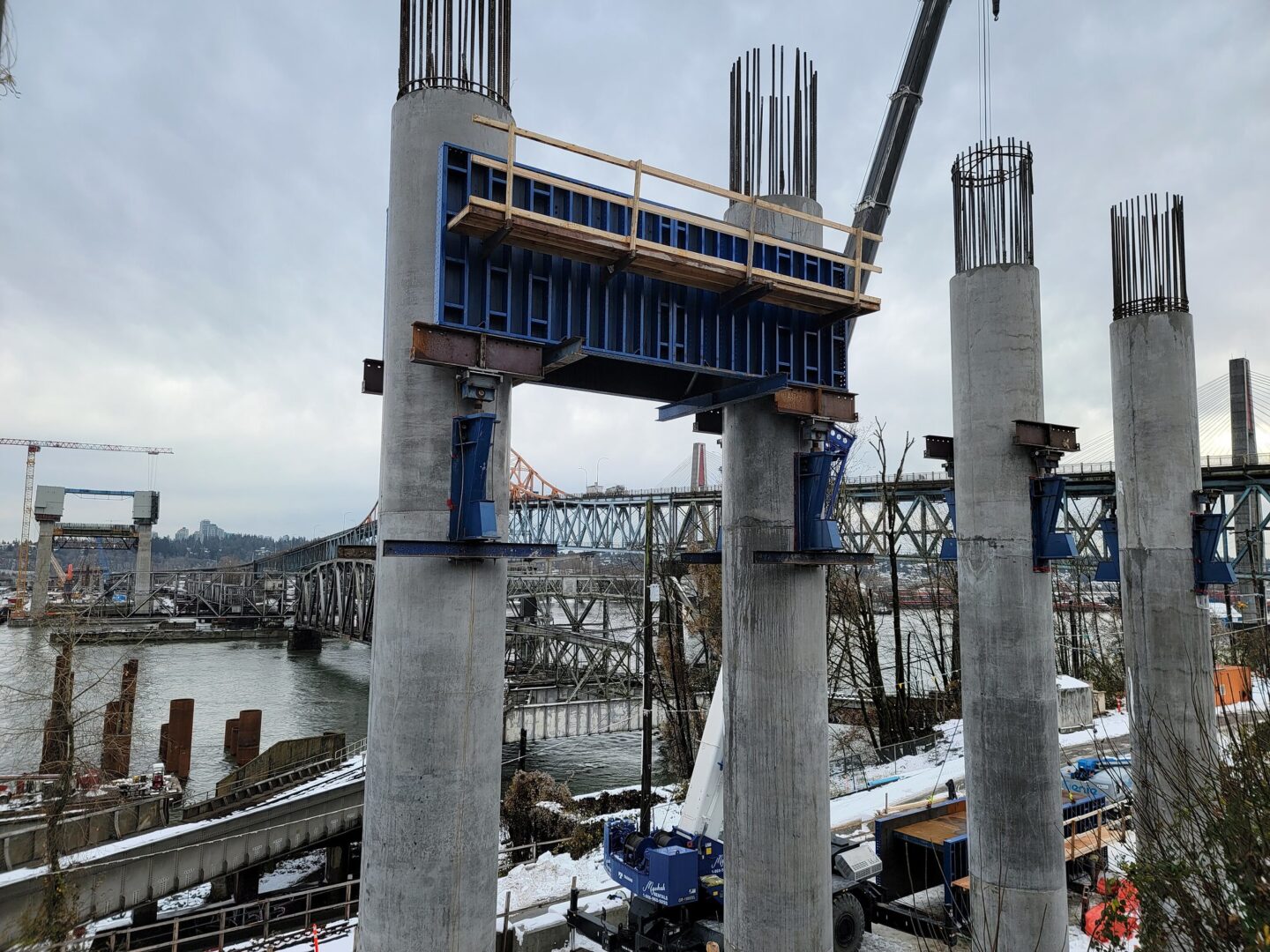
The Pattullo Bridge opened in 1937, connecting the communities of Surrey and New Westminster in British Columbia. At a total cost of $4 million, the bridge was originally tolled at 25 cents per crossing, with the toll later removed in 1952. Opening in 2024, the Pattullo Bridge is being replaced with a new four-lane toll-free bridge, which will maintain the vital link between the two growing communities, increasing safety and reliability for drivers, cyclists and pedestrians, and goods movement.
A new bridge was needed
“The traffic lanes on the current bridge are too narrow and the bridge requires lane closures at night for safety,” said Wendy Itagawa, executive project director, Pattullo Bridge Replacement, Transportation Investment Corporation. “As well, it has only one narrow sidewalk with no protection from traffic. The new four-lane crossing will have modern, wider lanes, separated by a centre median barrier that will enhance safety and improve connections to Surrey and New Westminster.”
The new bridge, scheduled to open in 2024, will be located just upstream and northeast of the existing bridge, optimizing the current road network and travel patterns. Dedicated walking and cycling pathways will be separated from traffic by a barrier on both sides of the bridge.

Transportation Investment Corporation, a province of British Columbia Crown corporation, is delivering and overseeing this $1.377 billion project. The project is being delivered under B.C.’s Community Benefits Agreement, and the project workforce is being provided by BC Infrastructure Benefits, a provincial Crown corporation. Fraser Crossing Partners (FCP) was selected to design, build and partially finance the new four-lane crossing during construction. The Government of B.C. will own and maintain the new bridge when complete.
FCP includes: Acciona Construccion S.A., Acciona Infrastructure Canada Inc., Aecon Group Inc., Aecon Constructors, a division of Aecon Construction Group Inc. Also part of the group are Leonhardt, Andra und Partner Beratende Ingenieure VGI AG, Hatch Corporation, EXP Services Inc. and VIA Architects. In addition, in-river pile installation was completed by Fraser River Pile and Dredge, and Aecon Foundations completed the bored piles on the north approach while the on-land piles on the south approach are being driven by the construction joint venture Fraser Crossing Constructors General Partnership.
New and improved design
“The new bridge has been designed to have a much smaller footprint in the water, consisting of two in-river piers, reduced from the six the current bridge has in the river,” said Itagawa. “This design has many advantages, including less construction time in the Fraser River, easier navigation of the river for marine users due to less infrastructure in the water and a reduced in-river footprint impact on aquatic life.”
Itagawa says the design allows for future expansion to six lanes if required; the walking and cycling paths would become vehicle lanes and new walking and cycling paths would be added to the outside of the bridge, cantilevered from the existing structure.
The cables on the new bridge will not cross over any travelling lanes, mitigating the risk of snow and ice forming on the cables and potentially falling on travelling lanes. In addition, the new bridge will include a snow and ice removal system. The new design also accommodates the City of New Westminster’s future waterfront greenway, habitat development and site restoration in Surrey.
Deep foundation operational challenges
Twelve separate piers will support the new bridge and approaches. There are two piers in-river, with pile depth reaching up to 67 metres. The remaining 10 piers are on-land in New Westminster and Surrey. Additional piers will support the new off-ramps and multi-use pathway structure.
Building such a complex project in a very constrained, highly urban area, as well as near other infrastructure in the river, brings many challenges, especially when considering the deep foundation work involved. Working in, above and around the Fraser River brings its own set of challenges to the project, especially regarding safety. It is the longest river in the province, beginning in the Rocky Mountains at Fraser Pass and flowing for 1,375 kilometres into the Strait of Georgia just south of Vancouver.
“The new four-lane crossing will have modern, wider lanes, separated by a centre median barrier that will enhance safety and improve connections to Surrey and New Westminster.”
Wendy Itagawa, Transportation Investment Corporation
“Safety has been and will continue to be a top priority on the project,” said Itagawa. “For in-river works, there was always a rescue boat present on the water during pile driving. FCP developed a safe job procedure for in-river and on-land piling work. All personnel working over water are required to wear a personal floatation device. FCP also developed emergency rescue plans for specific work areas.”
From a construction perspective, operations for the two in-river foundations had to consider navigation, allowable fish windows, underwater noise mitigation and the proximity of piling works to adjacent in-river structures. It also considered driving in-river piles without impacting marine life, river hydraulics and the environment, complying with a wide range of environmental requirements that come with building in and near the Fraser River.
Pile installation for the 12 main bridge foundations is complete, and construction of the bridge tower is underway and progressing well. Pile installation is underway for the Surrey off-ramp and multi-use path foundations, and will also be required for the New Westminster off-ramp and multi-use path foundations.

“A challenge for the on-land piling on the south side [Surrey] of the river is dealing with soft soils to support the ground-bearing pressures from the largest equipment [crane and hammer] that is required to perform the work,” said Itagawa. “The south side of the Fraser River delta is a challenging geotechnical environment, comprised of near-surface peat, organic silt and loose, saturated sands of various thicknesses. As a result, deep foundations that extend through the compressible layers into dense till or bedrock are required to mitigate long-term settlement, rather than using shallow foundations.”
Ground densification is being completed adjacent to essential bridge foundations on the south side to address liquefiable soil during a significant seismic event. Supporting embankments also use a combination of lightweight fill and ground improvement where necessary.
Significant infrastructure work is also taking place on the CN Rail bridge that crosses the river and coordination is required between the two projects. The pile driving schedule was developed to accommodate train movements on the adjacent rail bridge and to accommodate river vessel traffic. A tug assist had to be continuously available for river vessel traffic traversing the area during in-river piling.
Environmental sustainability
The Pattullo Bridge Replacement Project went through an environmental assessment led by the B.C. Environmental Assessment Office (EAO). Following the completion of the environmental assessment, the project received an Environmental Assessment Certificate from the EAO under B.C.’s Environmental Assessment Act.

A confined bubble curtain was in place to provide underwater noise mitigation for in-river piling. Itagawa says that this is the best mitigation option considering flow conditions and proximity to other infrastructure in the water – the nearby rail bridge. Also, the timing of in-river piling took place within Fisheries and Oceans Canada least risk window for fish (mid-June to end of January).
Getting the work done
For the in-river and Surrey foundations, driven piles were installed using a combination of vibro hammers, diesel hammers and hydraulic hammers. In addition, a drilled shaft methodology will be used for the New Westminster pile installation to reduce noise and vibration for nearby residents. In this method, no casing is installed into the ground and the ground is excavated by a rotary drill rig with the required diameter, which is two metres.
For in-water work, the main crane used to install the piles was a Manitowoc 4100 Ringer Mounted Crane with crane support provided by a Manitowoc 4000W. For the on-land work, the Liebherr LR1400 and the Liebherr LR1300 crawler cranes were used to drive the piles.

APE 300-6 and APE 600 vibratory hammers with quad jaw attachments were used to install the starter segments. Various combinations of hammers were used to achieve the pile design criteria for the two in-river foundations: D180 Diesel Impact Hammer, IHC S600 Hydraulic Impact Hammer and IHC S800 Hydraulic Impact Hammer. FCP also mobilized the S800 hammer to ensure the project had equipment with sufficient energy to manage any unforeseen geotechnical conditions.
Also, Itagawa says that temporary falsework frames were installed to set the geometry of the piles and allow a safe working platform for welding. The in-situ splice welds were performed manually and tested to ensure they met the technical requirements.
“Steel piles are used for in-river and on-land deep foundations, with the in-water piles stored on eight storage barges,” Itagawa said. “The tower foundation includes 27 2.5-metre-diameter piles while the second in-river foundation includes 15 2.5-metre-diameter piles. All on-land foundations are either two metres or 1.5 metres in diameter, founded on dense till. An on-land splice bed was set up to splice the pile starter segments prior to the commencement of work and automated welding machines were used at splice beds.”
On time and on target
Pile installation for the 12 main bridge foundations is now complete, and piling work is underway for the Surrey off-ramp and multi-use path foundations. Next will be the installation of piles for the New Westminster off-ramp and multi-use path foundations. Construction of the bridge tower is progressing well.
In the meantime, the existing bridge continues to serve its two communities on either side of the Fraser River as it has done for more than eight decades. Once the new Pattullo Bridge is complete, the original bridge will be removed and become another chapter in the story of the Fraser River delta.